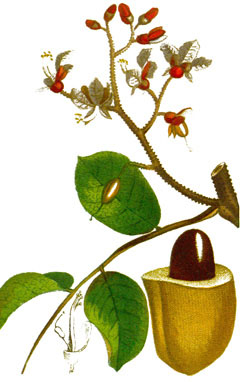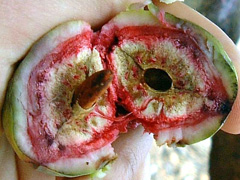 |
|
https://edibleplants.org/ |
 |
| https://edibleplants.org/ |
Translate this page:
Summary
Other common names include Brazilian Teak, Kumaru, and Cumarú de Cheiro. Dipteryx odorata or Tonka Beans is a tropical flowering tree native to Central America and northern South America. It grows up to 25-30 m with trunk diameter of about 1 m. It has a smooth and grey bark, alternate pinnate leaves that are glossy and dark green, and flowers that are pink. The crown is small and round. It is known for its seeds that are black and wrinkled, and have a strong fragrance due to high coumarin content. The seeds are used in perfumery and as a vanilla substitute. It is also used in French cuisine. However, commercial use of this as flavouring has been banned in some countries, particularly the USA. The seeds can also be used in the treatment of stomach pain, cough, and dysentery. The bark is astringent and febrifuge. The leaves can be used for earache.
Physical Characteristics

 Dipteryx odorata is an evergreen Tree growing to 30 m (98ft) by 20 m (65ft) at a medium rate.
Dipteryx odorata is an evergreen Tree growing to 30 m (98ft) by 20 m (65ft) at a medium rate.
See above for USDA hardiness. It is hardy to UK zone 10.
It can fix Nitrogen.
Suitable for: light (sandy), medium (loamy) and heavy (clay) soils and prefers well-drained soil. Suitable pH: mildly acid, neutral and basic (mildly alkaline) soils and can grow in very acid soils.
It can grow in semi-shade (light woodland) or no shade. It prefers moist soil and can tolerate drought.
UK Hardiness Map
US Hardiness Map
Synonyms
Coumarouna micrantha (Harms) Ducke Coumarouna odorata Aubl. Dipteryx micrantha Harms
Plant Habitats
Edible Uses
Edible Parts: Seed Seedpod
Edible Uses:
A coumarin-like flavouring can be extracted from the seed through a process of fermentation[ 46 , 301 ]. It has been used commercially as a vanilla substitute in flavouring a wide range of foods including baked goods, ice cream, cocoa etc[ 301 ]. Its use is banned in some countries because of the possibility that coumarins can cause health problems - see notes above on toxicity[ 238 ]. The seed pods are 5 - 6cm long and about 3cm in diameter[ 335 ]. The pulp inside the seedpod is eaten raw[ 335 ]. Seed - eaten after boiling to get rid of toxins[ 335 ].
References More on Edible Uses
Medicinal Uses
Plants For A Future can not take any responsibility for any adverse effects from the use of plants. Always seek advice from a professional before using a plant medicinally.
Antiasthmatic Antirheumatic Antispasmodic Astringent Cardiotonic Dysentery Emmenagogue Febrifuge
Mouthwash Stomachic
The bark is astringent and febrifuge[ 348 ]. A decoction, combined with the crushed whole plant of Tonina fluviatilis, is used to prepare an infant fortifier[ 348 ]. The fragrant seeds are a rich source of coumarin. They are considered to be antiasthmatic, antispasmodic, cardiotonic and emmenagogue[ 739 ]. A decoction of the seed and sugar is used as a cold remedy[ 348 ]. The seed is mixed with rum to make a tincture that is rubbed on snakebite, contusions and rheumatism[ 348 ]. The seeds have been used in the past to treat whooping cough, but recent research has shown that the aromatic coumarins they contain can have detrimental effects upon the heart and liver, and may also cause cancer[ 238 ]. The oil from the seeds is used to alleviate stomach aches, to treat sores in the mouth, to fortify the scalp and improve hair growth[ 739 ]. It is said to be effective in controlling dysentery[ 348 ]. A cold water infusion of the leaves is used as an ear wash to treat earache[ 348 ]. The leaves are crushed to make a snuff powder[ 348 ]. The seed contains coumarin, which is used in perfume and for flavouring tobacco and whisky[ 348 ]. Bark contains isoflavones and umbelliferone[ 348 ]. The leaves contains salicylic, hydroxycoumaric, coumaric and ferulic acids[ 348 ].
References More on Medicinal Uses
The Bookshop: Edible Plant Books
Our Latest books on Perennial Plants For Food Forests and Permaculture Gardens in paperback or digital formats.

Edible Tropical Plants
Food Forest Plants for Hotter Conditions: 250+ Plants For Tropical Food Forests & Permaculture Gardens.
More

Edible Temperate Plants
Plants for Your Food Forest: 500 Plants for Temperate Food Forests & Permaculture Gardens.
More

More Books
PFAF have eight books available in paperback and digital formats. Browse the shop for more information.
Shop Now
Other Uses
Cosmetic Fencing Hair Pot-pourri Wood
Agroforestry Uses:
The trees are grown to provide shade in cocoa plantations[310
]. Other Uses: Coumarin, obtained from the seeds, is added to perfumes as a fixative[ 238 ]. It is also an aromatic ingredient in tobaccos and snuffs[ 238 ]. The seeds are used in pot pourri[ 238 ]. The fresh heartwood is a reddish-brown or purplish-brown colour with attractive light yellowish-brown or purplish streaks, seasoning to a variegated reddish and yellowish brown but after exposure to light gradually becoming a uniform yellowish brown or light brown; it is distinctly demarcated from the 3 - 5cm wide band of brownish yellow or yellowish brown sapwood[ 378 ]. The texture is fine; lustre medium; the grain irregular to often interlocked; no distinctive taste but a faint vanilla-like or rancid odour; a waxy or oily feel is also a characteristic of the wood[ 348 ]. It is an extremely hard and heavy wood, similar to lignum vitae (Guaiacum spp.) in this respect[ 378 ]. The wood is also very strong, very dense, tough and very resistant to decay when in contact with the soil[ 378 ]. It is difficult to work because of its high density and hardness; hard to saw and bore, but if sawn or bored clean edges and holes result; when severely interlocked grain is not present, the wood planes and finishes to a smooth surface; it glues poorly, as do many other woods of very high density, but takes a high polish[ 378 ]. When unpainted wood is exposed to the elements, it weathers well as to surface smoothness and freedom from warp and checking[ 378 ]. The wood is used extensively for cogs and shafts, heavy construction, turnery, fishing rods, paving blocks, barge and dock fenders, and flooring. The wood is particularly well adapted for use in tool handles, agricultural implements, sporting goods, and other uses utilizing its high bending strength and good shock resistance qualities. The somewhat oily nature of the wood and its hardness allow its use for bearings, cogs, shafts, and other uses in place of lignum vitae, where friction wear is a problem. It makes excellent wood for railway crossties and posts, for it is durable and does not split when exposed to the elements[ 378 ]. This wood should also do exceptionally well as boat keels and frames, ice sheathing, industrial flooring, and specialty items requiring a strong durable wood. Small quantities have been shipped into the United States for high-grade face veneer[ 378 ].
Special Uses
Food Forest Nitrogen Fixer
References More on Other Uses
Cultivation details
A plant of the moister tropics, preferring a temperature that does not usually fall below about 15°c[ 238 ]. It grows best in areas where annual daytime temperatures are within the range 22 - 30°c, but can tolerate 16 - 34°c[ 418 ]. It prefers a mean annual rainfall of 2,000 - 2,500mm, but tolerates 1,300 - 4,000mm[ 418 ]. Succeeds in full sun or light shade[ 418 ]. Succeeds in a wide range of soils as long as they are well-drained, though it prefers a well-drained gravelly or sandy acid soil with ample rainfall and humidity[ 238 , 378 ]. Prefers a pH in the range 5.5 - 6.5, tolerating 5 - 8.5[ 418 ]. Established plants can tolerate a certain amount of drought[ 378 ]. Seedling trees take about 5 years before they begin producing fruits[ 335 ]. Trees can commence production when just two years old if carefully cultivated, taking 7 - 10 years without cultivation[ 418 ]. Local varieties had been developed in Brazil and Venezuela[ 335 ]. This species has a symbiotic relationship with certain soil bacteria, these bacteria form nodules on the roots and fix atmospheric nitrogen. Some of this nitrogen is utilized by the growing plant but some can also be used by other plants growing nearby[ 200 ].
References Carbon Farming Information and Carbon Sequestration Information
Temperature Converter
Type a value in the Celsius field to convert the value to Fahrenheit:
Fahrenheit:
The PFAF Bookshop
Plants For A Future have a number of books available in paperback and digital form. Book titles include Edible Plants, Edible Perennials, Edible Trees,Edible Shrubs, Woodland Gardening, and Temperate Food Forest Plants. Our new book is Food Forest Plants For Hotter Conditions (Tropical and Sub-Tropical).
Shop Now
Plant Propagation
Seed - it has a very short viability and needs to be sown as soon as it is ripe[ 238 ]. Best sown in situ or in individual containers, since seedlings do not transplant well, fresh seed germinates in about 6 weeks[ 238 ].
Other Names
If available other names are mentioned here
Tonka Bean, Brazilian Teak, Tonka Bean, Cumarú de Cheiro, cumaru-de-cheiro cumaru-do-amazonas cumaru-verdadeiro cumarurana cumaruzeiro dutch tonka dutch tonka-bean fava tonka fève tonka haba tonka sarrapia tonga-bean tongo tongo bean tonka tonka bean tonka, bean tonka-bean tonkabohne tonkabohnenbaum tonkaböna, Cimaru, Coumarou, Tonquin bean, Cumaru, Dutch Tonka bean, Gaiac, Guayac, Karapa Bossi, Muirapaye, Choiba, Sarrapia,
Native Range
SOUTHERN AMERICA: French Guiana, Guyana, Suriname, Venezuela, Brazil (Amazonas (east), Mato Grosso (north), Pará), Colombia, Peru (east)
Weed Potential
Right plant wrong place. We are currently updating this section.
Please note that a plant may be invasive in one area but may not in your area so it's worth checking.
Conservation Status
IUCN Red List of Threatened Plants Status : This taxon has not yet been assessed.

Growth: S = slow M = medium F = fast. Soil: L = light (sandy) M = medium H = heavy (clay). pH: A = acid N = neutral B = basic (alkaline). Shade: F = full shade S = semi-shade N = no shade. Moisture: D = dry M = Moist We = wet Wa = water.
Now available:
Food Forest Plants for Mediterranean Conditions
350+ Perennial Plants For Mediterranean and Drier Food Forests and Permaculture Gardens.
[Paperback and eBook]
This is the third in Plants For A Future's series of plant guides for food forests tailored to
specific climate zones. Following volumes on temperate and tropical ecosystems, this book focuses
on species suited to Mediterranean conditions—regions with hot, dry summers and cool, wet winters,
often facing the added challenge of climate change.
Read More
Expert comment
Author
(Aubl.) Willd.
Botanical References
Links / References
For a list of references used on this page please go here
A special thanks to Ken Fern for some of the information used on this page.
Readers comment
| Add a comment |
|
If you have important information about this plant that may help other users please add a comment or link below. Only comments or links that are felt to be directly relevant to a plant will be included. If you think a comment/link or information contained on this page is inaccurate or misleading we would welcome your feedback at [email protected]. If you have questions about a plant please use the Forum on this website as we do not have the resources to answer questions ourselves.
* Please note: the comments by website users are not necessarily those held by PFAF and may give misleading or inaccurate information.
To leave a comment please Register or login here All comments need to be approved so will not appear immediately.
|
Subject : Dipteryx odorata
|
|
|
|